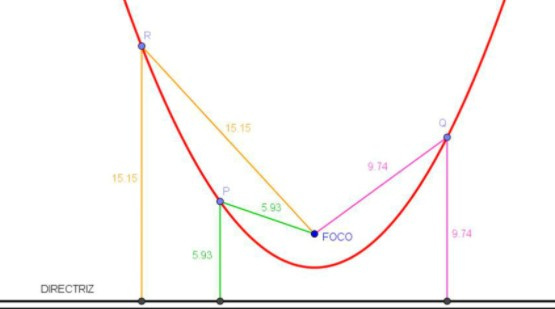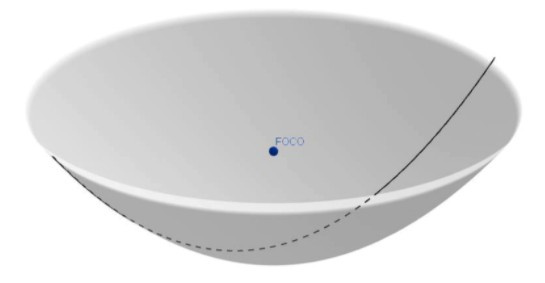
|
11 marzo 2025
What is a satellite dish?
Commercial satellites operate in frequency bands classified as microwave, L-band, C-band, Ku-band, and Ka-band. However, these frequencies are so high that they cannot be distributed via coaxial cable and must be converted to lower frequencies.
In the case of commercial satellite television signals, the IF band (intermediate frequency) is the band used for distribution via coaxial cable. Satellite dishes are also commonly used for point-to-point terrestrial microwave links.
How does it work?
The shape of satellite dishes is neither a matter of aesthetics nor the whim of a manufacturer. Rather, it responds to a purely mathematical question that cleverly uses a property of parabolas, known for almost 2,000 years.
What are parabolas? A parabola is a conic (a curve that arises when a cone is cut in a certain way) defined as the set of points that are equidistant from a specific point, called the focus, and a certain straight line, called the directrix. In the following image, we can see a parabola (in red), its focus and directrix, as well as the equal distances from various points to those two objects:

From this definition, it's easy to construct a 3D object by rotating the parabola about a vertical axis passing through its focus. This results in a three-dimensional surface called a paraboloid.

We've just created a satellite dish with the same focus as the parabola we rotated. A point inside the parabola moving along a straight line parallel to the axis will "bounce" off the parabola and be sent toward the focus.
This means that if we send signals parallel to the axis toward the parabola, they will be reflected back toward the focus, regardless of the line we use. This is very useful because, with a paraboloid that has a signal receiver placed at the focus, we can ensure that all signals that bounce off it are sent toward that receiver, without having to point it directly at it. In other words, with a small receiver, we obtain excellent signal reception, utilizing the entire surface of the paraboloid in the manner described.
On the other hand, this property can also be used in reverse. We place a signal emitter at the focus of the paraboloid, oriented toward the paraboloid, and emit the signal toward as much of its surface as possible. All signals will "bounce" and reflect outward parallel to its axis, thus achieving a greater signal emission than we would obtain by emitting from only one point. For example, this can be used in vehicle headlights (placing a light bulb at the focus to emit a greater amount of light) or in parabolic microphones (with a microphone at the focus to emit sound over a larger surface area).
The focus of the paraboloid is attached to a straight bar that rests on its surface (it must be secured somehow). This creates the problem that some signals can bounce off this bar, both when transmitting and receiving, and therefore be lost. To avoid this, what is sometimes done is to use a portion of the paraboloid for the satellite dish that is not "below" the focus, but "to one side." This way, we avoid these bouncing signals on the supports and achieve a more efficient antenna.
How is a satellite dish composed?
The main components of a satellite antenna are:
The shape of the reflector gives the antenna various properties, such as its high directionality and its suitability for working with extremely high frequencies. However, its main characteristic is that all electromagnetic waves that strike it are reflected and concentrated in a single point called the focus, generating high gain there.
The LNB (Low Noise Block) is responsible for capturing the high-frequency signal from the satellite and converting it into a lower-frequency signal, allowing its distribution through the coaxial cable. The BUC (Block Up-Converter) performs the reverse function, amplifying and converting the frequencies coming from the coaxial cable into higher ones, before transmitting them to the satellite. Both the LNB and the BUC require a feed horn, which is responsible for channeling the waves between the reflector and the active element.
Thus, depending on the active element installed, satellite dishes can be:
In addition to these main components, they can also include a series of accessories to improve their performance, such as a motor (to automatically orient the satellite antenna to different satellites), heating blankets (to prevent ice or snow from accumulating on the reflector), radomes (covering the antenna that protects it from weather and wildlife, without affecting its electromagnetic properties), etc.
What types of satellite antennas are available?
Over time, these types of antennas have been refined, reducing the size of the reflector without losing performance. Thus, there are several types of satellite or parabolic antennas:
Primary focus or centered parabolic antenna: This was the first to be used; its focus is located on the central axis of the reflector. It is completely symmetrical and parabolic. The active element is suspended in front of the reflector on its central axis, creating a shadowed area. It is also known as a C-Band satellite dish, as it is the one used for this band, although it is also used for Ku-Band frequencies and for point-to-point terrestrial microwave links.
Offset or offset-focus satellite dish: The reflector is not completely round; its shape is a section of an oval paraboloid reflector. As its name suggests, its focus is offset from the center of the antenna, preventing the active element from casting a shadow on the reflecting parabola. Because the focus is offset, this type of antenna does not point perpendicularly to the satellite, but is tilted approximately 25° downward. They are not suitable for C-Band satellites.
Cassegrain satellite dish: This is an antenna with a main concave parabolic reflector and a smaller convex secondary reflector, suspended in front of the main reflector and close to the focus, such that electromagnetic waves, when incident on one reflector, are reflected to the next.
Flat satellite dish: Also called a planar array. Although not physically a satellite dish as such, it is a compact antenna for receiving satellite signals, notable for its small size and visual impact on installations. It is intended for domestic installations and the Ku Band, with a good level of satellite coverage footprint.

27 enero 2025
In a hyper-connected world, corporate communications networks are the backbone of any modern enterprise. With the exponential increase in data exchange and reliance on digital services, the need for a robust, efficient and secure network has never been more crucial.

03 abril 2025
Satellites have the capacity to deliver essential services to citizens regardless of location, terrain conditions, or population density. Therefore, facilitating satellite deployment by lightening the regulatory burden helps, for example, address the digital divide through broadband satellite services, capable of providing connectivity to 100% of the population.